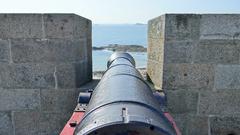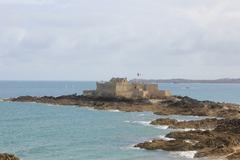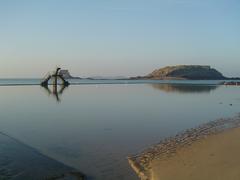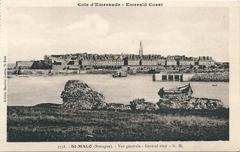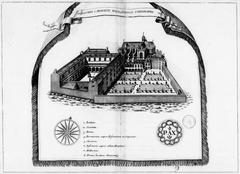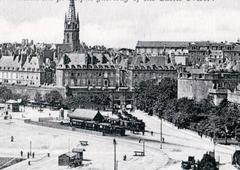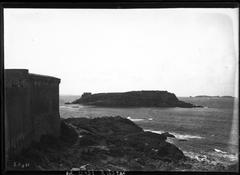
Solidor Tower Visiting Hours, Tickets, and Historical Significance in Saint-Malo
Date: 04/07/2025
Introduction
Located in the historic Saint-Servan district of Saint-Malo, France, Solidor Tower (Tour Solidor) is a striking medieval fortress and one of Brittany’s most iconic landmarks. Erected between 1369 and 1382 by John IV, Duke of Brittany, the tower was originally built to assert ducal control over Saint-Malo and to guard the vital estuary of the Rance River. Distinguished by its triangular layout of three interconnected round towers, Solidor Tower reflects the evolution of medieval military architecture and serves as a living testament to the region’s maritime and military heritage (castles.nl; Wikipedia).
Over the centuries, the tower has been repurposed as a prison and most recently as a maritime museum celebrating the achievements of Breton sailors, especially those who braved the treacherous waters around Cape Horn. Today, Solidor Tower offers visitors the opportunity to explore its dramatic architecture, captivating history, and panoramic views over the Rance estuary and Saint-Malo bay (cityzeum.com; saint-malo.fr). This guide provides comprehensive information on Solidor Tower’s visiting hours, ticketing, accessibility, architectural features, and its enduring cultural and maritime significance.
Table of Contents
- Historical Overview
- Architectural Features and Layout
- Cultural and Maritime Significance
- Visiting Information
- Nearby Attractions and Local Insights
- Visuals and Multimedia
- Frequently Asked Questions (FAQ)
- Conclusion and Visit Tips
- References and Further Reading
Historical Overview
Origins and Construction
Solidor Tower was commissioned by John IV, Duke of Brittany, as a strategic fortress to control the estuary of the Rance River and assert authority over the once-independent city of Saint-Malo. Built between 1369 and 1382, the tower’s triangular design—three interconnected cylindrical towers—was intended to maximize defensive coverage and withstand attacks (castles.nl; spottinghistory.com).
Architectural Significance
This medieval keep is a prime example of advanced military architecture for its time. The three rounded towers, connected by robust granite curtain walls, form a triangular enclosure. Narrow arrow slits, thick stone walls, and a high vantage point allowed defenders to monitor and protect the river estuary, while the use of local granite ensured durability against sieges and the harsh maritime environment (Nomads Travel Guide; France Voyage).
Key Historical Roles
- Late 14th–16th centuries: Served as a powerful symbol of ducal authority and a key defensive outpost.
- French Revolution: Used as a prison because of its formidable structure.
- 19th century: Continued as a prison and customs post.
- 1886: Declared a historic monument, ensuring preservation (Wikipedia).
Restoration and Museum Era
In the 20th century, Solidor Tower became home to the Musée International du Long-Cours Cap Hornier, dedicated to the history of long-haul sailing and Cape Horners. Though the museum closed in 2022, the tower remains a site for exhibitions and cultural events, and ongoing restoration aims to enhance visitor experience (cityzeum.com; spottinghistory.com).
Architectural Features and Layout
Exterior and Defensive Features
The triangular plan of Solidor Tower is formed by three cylindrical towers, each approximately 18 meters high, linked by thick granite walls. Its elevated rocky promontory grants wide-ranging views and makes it difficult to assault. Features such as arrow slits, machicolations, and formerly a drawbridge (now a stone bridge) underline its defensive role (St-Malo.com; Saint-Malo.fr).
Interior Structure
Inside, the tower comprises three main floors in each tower, connected by a spiral staircase of 104 steps. The interior is austere, with vaulted ceilings, small windows, and thick granite walls. Originally, these spaces housed garrisons and supplies, later converted for prison and museum use (Hotel des Abers).
Materials and Symbolism
Local granite provides strength and resilience, while the conical slate roofs (added during restoration) maintain the tower’s historic silhouette. Later additions, like the commemorative cross for Jacques Cartier, add layers of meaning to the site (France Voyage).
Cultural and Maritime Significance
Strategic Importance
Solidor Tower’s position at the mouth of the Rance estuary allowed control over maritime trade and defense against naval threats. As a linchpin in Brittany’s coastal defenses, it played a crucial role in the region’s political and economic history (cityzeum.com).
Evolution of Function
While originally a fortress, Solidor Tower later served as a prison and customs post, reflecting the changing needs of Saint-Malo. In the 20th century, it was transformed into a museum celebrating the city’s maritime legacy—especially the exploits of Cape Horners (cityzeum.com; Nomads Travel Guide).
Maritime Heritage and Community Identity
The tower stands as a symbol of Saint-Malo’s seafaring past. The former museum’s collections—ship models, navigational equipment, and sailors’ stories—honored the city’s role as a hub for explorers and privateers. Today, the Solidor district remains a vibrant area full of Breton culture and gastronomy (cityzeum.com).
Underwater Heritage Initiatives
Recent projects, such as the virtual reality dive into the “Feltar” shipwreck, have expanded the tower’s role as a center for maritime heritage interpretation. These experiences offer visitors innovative ways to connect with Saint-Malo’s underwater archaeology (irisa.fr).
Visiting Information
Hours, Tickets, and Accessibility
-
Visiting Hours:
- April–September: Tuesday–Sunday, 10:00 AM–6:00 PM
- October–March: Wednesday–Sunday, 1:00 PM–5:00 PM
- Closed Mondays and select holidays.
-
Tickets:
- Adults: €6
- Reduced (students, seniors): €4
- Children under 12: Free
- Group rates available; check official site for details.
-
Accessibility:
The tower’s medieval design includes steep staircases and uneven floors; accessibility is limited for those with reduced mobility. Contact the site ahead for specific needs.
Guided Tours and Events
Guided tours are offered seasonally, providing expert insights into the tower’s history and architecture. Cultural events, exhibitions, and virtual heritage experiences take place throughout the year—check the official website for current programming.
Travel Tips
- Combine your visit with nearby attractions such as Fort Aleth, the Saint-Malo ramparts, and the vibrant Saint-Servan neighborhood.
- Comfortable shoes are recommended for climbing stairs and navigating stone floors.
- Early morning or late afternoon visits offer the best light for photography and fewer crowds.
- The surrounding area has cafés, local markets, and scenic waterfront walks.
Nearby Attractions and Local Insights
The Solidor district features cobbled streets, local markets, and the picturesque Port of Saint-Servan. Other nearby highlights include:
- Cité d’Aleth: Ancient fortified site with panoramic views.
- Intra-Muros: Saint-Malo’s historic walled city, full of museums, shops, and restaurants.
- Beaches and Harbor: Beautiful coastal walks and maritime scenery.
The area is easily accessible on foot from central Saint-Malo (about 20–30 minutes) and by public transport or car, with parking available nearby (Trip2France).
Visuals and Multimedia
Visitors can explore high-quality images and virtual tours on the Saint-Malo Tourism website. Suggested visuals include:
- Exterior shots of Solidor Tower with alt text such as “Solidor Tower medieval granite exterior.”
- Interior spiral staircases (“Interior spiral staircase of Solidor Tower”).
- Panoramic views from the walkway (“Panoramic view from Solidor Tower over Rance estuary”).
- Photos of the surrounding Saint-Servan district and harbor.
Multimedia offerings, such as the virtual reality shipwreck experience, are occasionally available onsite (irisa.fr).
Frequently Asked Questions (FAQ)
Q: What are Solidor Tower’s opening hours?
A: Typically, April–September: Tuesday–Sunday, 10:00 AM–6:00 PM; October–March: Wednesday–Sunday, 1:00 PM–5:00 PM. Always check the official website before visiting.
Q: How much are tickets?
A: Adults €6; reduced €4; free for children under 12. Group rates are available.
Q: Is the tower wheelchair accessible?
A: Due to steep, narrow stairs and uneven medieval floors, accessibility is limited. Contact the site in advance for details.
Q: Are guided tours available?
A: Yes, especially during weekends and peak seasons. Inquire at the ticket desk or online for schedules.
Q: What other attractions are nearby?
A: The Cité d’Aleth, Saint-Malo ramparts, Château de Saint-Malo, and vibrant Saint-Servan markets are all within easy reach.
Conclusion and Visit Tips
Solidor Tower is a remarkable destination for history lovers, architecture enthusiasts, and anyone seeking to experience the maritime spirit of Saint-Malo. Its commanding presence, rich layered history, and breathtaking views make it a highlight of any visit to Brittany. For the best experience:
- Confirm opening hours and ticket information on the official tourism website.
- Wear comfortable shoes and prepare for stairs.
- Explore the Saint-Servan area for cultural and culinary delights.
- Enhance your visit with multimedia guides or virtual experiences.
To further enrich your trip, download the Audiala app for guided tours and audio commentary. Follow us on social media for up-to-date news, and explore related posts for more travel inspiration across Brittany.





